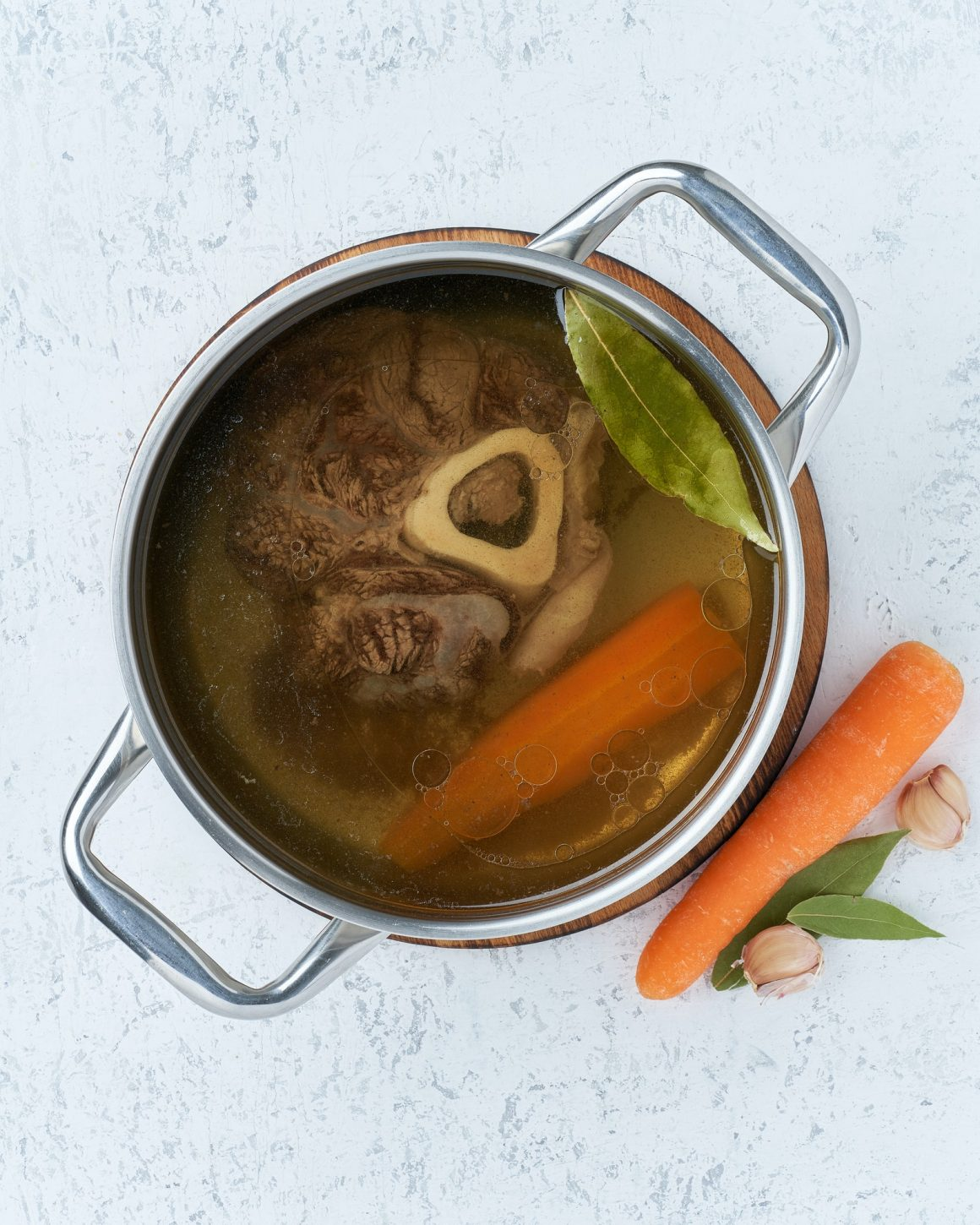One Pan Keto Beef Stroganoff: A Delightful Low-Carb Delicacy for a Healthy Lifestyle
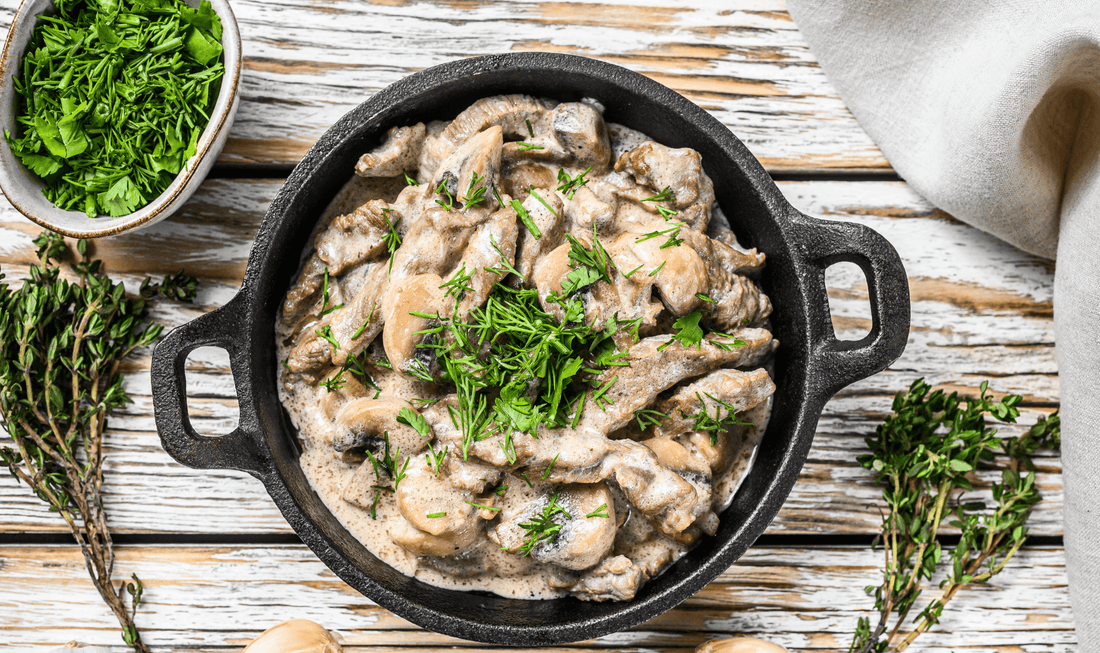
Welcome to a culinary adventure that combines the richness of traditional beef stroganoff with the health benefits of a keto-friendly diet. In this heartwarming recipe, we'll take you step by step through creating a luscious and savoury dish that will tantalise your taste buds and leave you fully satisfied. Keto beef stroganoff is the perfect choice for those seeking a comforting meal while staying true to their low-carb lifestyle. So, grab your apron, sharpen your chef's knife, and embark on this culinary journey together.
Unravelling the Rich History of Beef Stroganoff: From Classic to Keto
Beef Stroganoff is a beloved classic dish that has stood the test of time. Its tender beef, creamy sauce, and flavourful seasonings have become a staple on dinner tables worldwide. But did you know that this iconic dish has a fascinating history? Let's journey back in time to discover the origins of Beef Stroganoff and explore how we can transform it into a keto-friendly delight.
The story of Beef Stroganoff dates back to 19th-century Russia. It is believed to have been named after the influential Stroganov family, who were prominent members of the Russian aristocracy. Legend has it that the dish was created by a French chef in the service of Count Pavel Stroganov, who wanted to impress his esteemed guests with a sumptuous meal. The original version featured thin strips of beef sautéed in butter, smothered in a rich sour cream sauce, and often served over noodles or rice.
Fast forward to today, many people are embracing the keto lifestyle and seeking low-carb alternatives to their favourite dishes. Fortunately, it is entirely possible to enjoy a keto-friendly version of Beef Stroganoff without compromising on taste or tradition.
A few simple swaps can transform Beef Stroganoff into a keto-friendly delight. First and foremost, we substitute the traditional flour used to thicken the sauce with alternatives such as almond flour or coconut flour, which are low in carbs and high in fibre. Additionally, we substitute high-carb noodles or rice with low-carb options like cauliflower rice or zucchini noodles, keeping the dish satisfyingly delicious while keeping the carb count in check.

While the essence of Beef Stroganoff lies in its succulent beef and luscious sauce, we can adapt the ingredients to align with the principles of the keto diet. Opting for high-quality grass-fed beef ensures a richer flavour profile and a healthier fat profile. Incorporating mushrooms, onions, and garlic not only adds depth and complexity but also contributes to the overall nutritional value of the dish.
The creamy part of the sauce can still be enjoyed on a keto diet by using full-fat sour cream or Greek yogurt, both of which are low in carbs and high in healthy fats. To enhance the flavours, we can experiment with keto-friendly seasonings and herbs such as paprika, Dijon mustard (my secret weapon in cooking), and fresh parsley.
We can indulge in this comforting and satisfying dish while maintaining our low-carb lifestyle by revamping the classic Beef Stroganoff recipe with keto-friendly ingredients and mindful substitutions. The result is a keto version that pays homage to the traditional flavours while offering a guilt-free and nourishing dining experience.
So, whether you're a fan of the historical roots of Beef Stroganoff or a keto enthusiast seeking new culinary adventures, don't hesitate to embark on this flavourful journey. With a bit of creativity and a keto mindset, you can savour the delightful essence of Beef Stroganoff while staying true to your low-carb goals.
Beef is an Absolute Staple on the Keto Diet!
Beef, a staple in many diets, is a versatile and nutrient-rich protein source that can be enjoyed as a part of a well-balanced ketogenic lifestyle. As for the benefits of beef in a keto diet, several vital aspects must be considered.
-
High-Quality Protein: Beef is an excellent source of high-quality protein, providing all the essential amino acids needed for muscle growth, repair, and overall maintenance. Protein is a crucial macronutrient in a ketogenic diet as it helps promote satiety, preserves lean muscle mass, and supports metabolic function.
-
Healthy Fats: While beef is known for its protein content, it also contains varying amounts of healthy fats, depending on the cut. Fatty cuts of beef, such as ribeye or brisket, provide a good balance of saturated and monounsaturated fats. These fats are valuable in a ketogenic diet as they contribute to satiety, help maintain energy levels and support ketosis, the metabolic state where the body uses fat as its primary fuel source.
-
Micronutrient Richness: Beef is a nutrient-dense food packed with essential vitamins and minerals. It is prosperous in B vitamins, including B12, crucial for red blood cell production and neurological function. Furthermore, beef is a good source of iron, zinc, selenium, and other minerals that play vital roles in immune function, energy production, and overall health.
-
Conjugated Linoleic Acid (CLA): Grass-fed beef, in particular, contains higher levels of conjugated linoleic acid (CLA), a beneficial fatty acid. CLA has been associated with various health benefits, including improved body composition, reduced inflammation, and enhanced heart health. It is worth noting that the CLA content is generally higher in grass-fed beef compared to conventionally raised beef.
-
Nutrient Bioavailability: Beef is well-known for its high bioavailability of nutrients. This fact means that the body can efficiently absorb and utilise the vitamins and minerals found in beef. This attribute is especially significant in a ketogenic diet, where the emphasis is on obtaining essential nutrients from whole food sources.
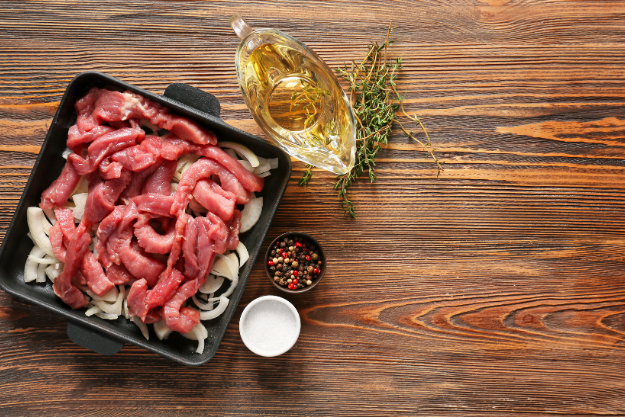
When incorporating beef into your ketogenic meal plan, it's essential to choose high-quality, grass-fed, or pasture-raised beef whenever possible. These sources tend to offer a better nutrient profile, including higher levels of omega-3 fatty acids and antioxidants.
However, it's important to note that while beef can be a valuable component of a keto diet, moderation and balance are key. Opt for leaner cuts of beef if you're watching your fat intake, and aim to incorporate a variety of protein sources to ensure a well-rounded nutrient intake.
In conclusion, beef provides numerous benefits in a ketogenic diet, including high-quality protein, healthy fats, essential nutrients, and potential health-boosting components like CLA. Enjoying beef as a part of a diverse and balanced keto meal plan can contribute to overall health, satiety, and enjoyment of your dietary journey.
Ingredients
To create the ultimate keto beef stroganoff, we'll need a carefully curated selection of ingredients that harmonise perfectly to deliver a burst of flavours. Here's what you'll need:
-
2 pounds of beef tenderloin, thinly sliced
-
1 tablespoon of olive oil
-
1 onion, finely chopped
-
2 cloves of garlic, minced
-
8 ounces of mushrooms, sliced
-
1 cup of beef broth, preferably homemade (homemade recipe below!)
-
1 tablespoon of Dijon mustard
-
1 cup of sour cream, full fat
-
Salt and pepper to taste
-
Fresh parsley, chopped (for garnish)
-
Almond flour (optional and to be used to thicken the sauce if needed)
Instructions
-
Prepare the Beef: Begin by heating a tablespoon of olive oil in a large skillet over medium-high heat. Add the thinly sliced beef tenderloin to the skillet and season it generously with salt and pepper. Sear the beef for about 2 minutes on each side until it develops a beautiful golden-brown crust. Once done, transfer the beef to a plate and set it aside.
-
Sauté the Aromatics: In the same skillet, add the finely chopped onion and minced garlic. Sauté them until they turn translucent and fragrant, usually taking about 3-4 minutes. This will infuse your stroganoff with irresistible flavours.
-
Add the Mushrooms: Add the sliced mushrooms to the skillet and cook them until they become tender and golden brown. This process typically takes around 5 minutes. As the mushrooms cook, they release their natural juices, enhancing the overall depth of flavour in the dish.
-
Deglaze with Beef Broth: Once the mushrooms are cooked to perfection, pour in the beef broth (either homemade or store-bought), carefully deglazing the skillet to incorporate all the flavourful bits stuck to the bottom. This step adds a rich and savoury dimension to the stroganoff. Allow the mixture to come to a gentle simmer, then reduce the heat to medium-low.
-
Incorporate Dijon Mustard: Stir in the Dijon mustard, which adds a tangy and slightly piquant note to balance the dish's richness. The mustard also helps to thicken the sauce, giving it a velvety texture.
-
Simmer and Thicken: Let the mixture simmer for about 5 minutes, allowing the flavours to meld together and the sauce to reduce slightly. This step ensures a concentrated taste that will have you craving more. If you wish for the sauce to thicken more, gradually add small amounts (a tablespoon) of almond meal and stir in well.
-
Introduce the Sour Cream: Reduce the heat to low and gradually stir in the full-fat sour cream, ensuring it blends seamlessly with the sauce. The sour cream imparts a luxurious creaminess and tanginess, characteristic of the classic stroganoff.
-
Reintroduce the Beef: Gently return the seared beef tenderloin to the skillet, nestling it in the luscious sauce. Allow the beef to warm through in the sauce for approximately 5 minutes. This process ensures the meat absorbs the flavours while remaining tender and succulent.
-
Final Touches: Taste the stroganoff and adjust the seasoning with salt and pepper according to your preferences. Remember to keep in mind that flavours develop further as the dish rests.
-
Serving and Garnishing: Once you are satisfied with the taste, remove the skillet from the heat. Serve the keto beef stroganoff in warm bowls or plates, garnishing each portion with a sprinkle of fresh chopped parsley. This adds a pop of colour and a subtle herbaceous note.
There you have it—the ultimate keto beef stroganoff, a culinary masterpiece showcasing comfort and satisfaction without compromising your low-carb goals. This dish's velvety sauce, tender beef, and earthy mushrooms create a symphony of flavours that will transport you to a place of culinary bliss. Whether hosting a dinner party or simply enjoying a cozy night in, this recipe will impress your taste buds and leave you feeling nourished and content.
Remember, cooking is an art, and recipes are merely guidelines. Feel free to experiment with additional ingredients, such as fresh herbs or low-carb vegetables, to tailor this keto beef stroganoff to your personal preferences. So, embrace the joy of cooking, savour each bite, and relish in the knowledge that you can enjoy a delicious meal that aligns perfectly with your keto lifestyle.
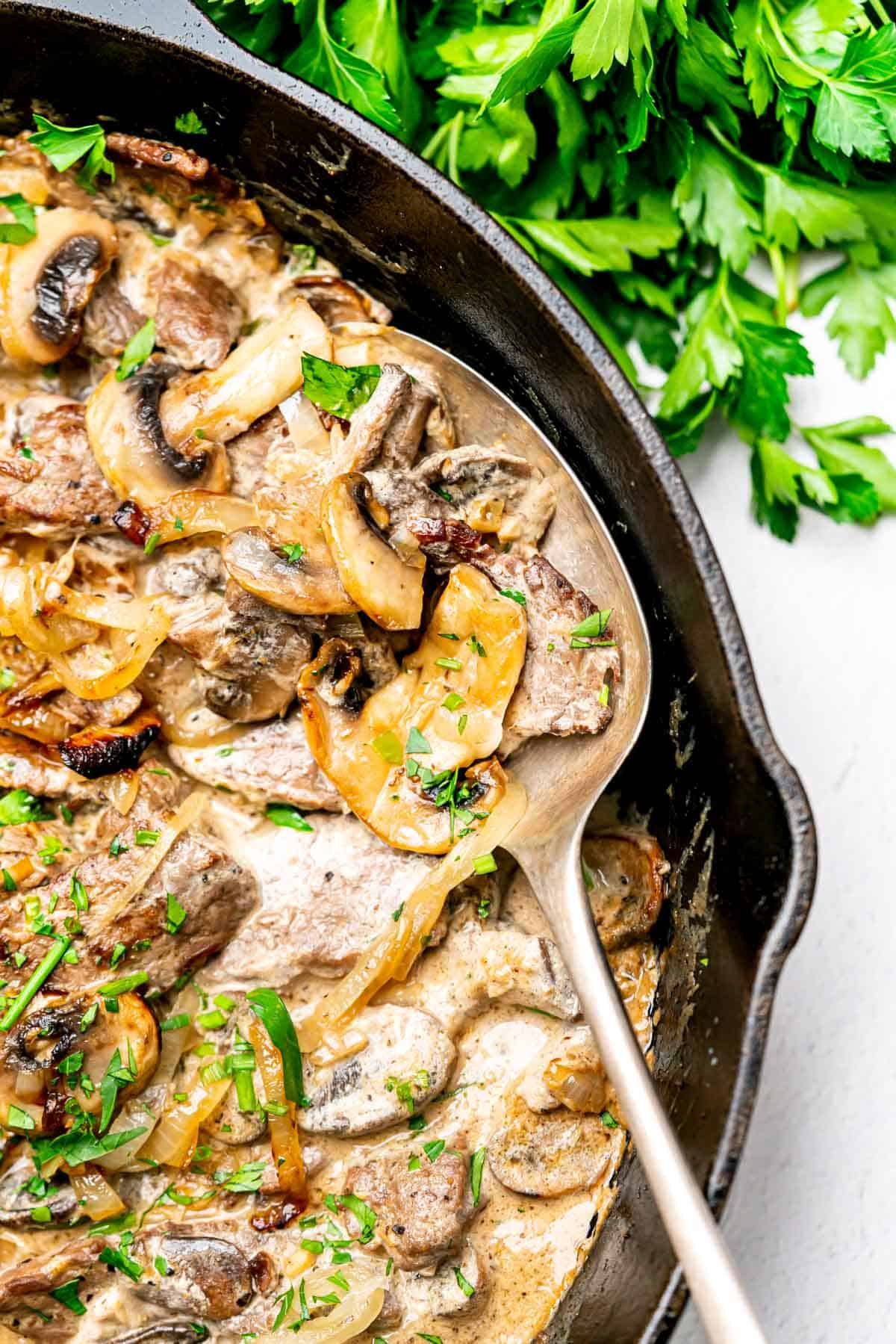
Macronutrients of this Meal: Protein-Rich Foods
To calculate the macronutrients in the keto beef stroganoff meal, we need to consider the nutritional content of each ingredient used. Here's an approximate breakdown of the macronutrients based on the ingredients provided:
Note: The following macronutrient values are approximate and can vary depending on the specific brands and quantities used.
Serves 4
Beef Tenderloin (2 pounds):
-
Protein: Approximately 184 grams
-
Fat: Approximately 56 grams
-
Carbohydrates: 0 grams
Olive Oil (1 tablespoon):
-
Protein: 0 grams
-
Fat: Approximately 14 grams
-
Carbohydrates: 0 grams
Onion (1 medium-sized):
-
Protein: Approximately 2 grams
-
Fat: Approximately 0 grams
-
Carbohydrates: Approximately 14 grams
Garlic (2 cloves):
-
Protein: Approximately 2 grams
-
Fat: Approximately 0 grams
-
Carbohydrates: Approximately 1 gram
Mushrooms (8 ounces):
-
Protein: Approximately 6 grams
-
Fat: Approximately 0 grams
-
Carbohydrates: Approximately 4 grams
Beef Broth (1 cup):
-
Protein: Approximately 2 grams
-
Fat: Approximately 0 grams
-
Carbohydrates: Approximately 2 grams
Dijon Mustard (1 tablespoon):
-
Protein: Approximately 0 grams
-
Fat: Approximately 0 grams
-
Carbohydrates: Approximately 0 grams
Sour Cream (1 cup):
-
Protein: Approximately 16 grams
-
Fat: Approximately 45 grams
-
Carbohydrates: Approximately 6 grams
Salt and Pepper:
-
Protein: 0 grams
-
Fat: 0 grams
-
Carbohydrates: 0 grams
Fresh Parsley (for garnish):
-
Protein: Approximately 1 gram
-
Fat: Approximately 0 grams
-
Carbohydrates: Approximately 1 gram
Total Macronutrient Breakdown for the Keto Beef Stroganoff (Approximate Values per Serve)
-
Protein: Approximately 53 grams
-
Fat: Approximately 28 grams
-
Carbohydrates: Approximately 7 grams
Just so you know, these values are estimates and can vary depending on the specific brands, quantities, and cooking methods used. It's always a good idea to double-check the nutrition labels of the exact ingredients you use or use a reliable nutrition calculator to get accurate macronutrient information for your meal.
Pair with these Fabulous Keto Side Options
When it comes to choosing keto-friendly side dishes to complement your beef stroganoff, you have several delicious options. Here are some ideas to consider:
-
Cauliflower Rice: Swap traditional rice with cauliflower rice, which is low in carbs and adds a similar texture to the rice. Sauté it in a skillet with some olive oil, garlic, and seasonings for a flavorful and keto-friendly side.
-
Zucchini Noodles: Spiralise fresh zucchini into noodle-like strands and lightly sauté them in a pan with olive oil. Zucchini noodles, or "zoodles," make a light and refreshing side dish that pairs well with the richness of the stroganoff.
-
Steamed or Roasted Vegetables: Choose low-carb vegetables like broccoli, asparagus, Brussels sprouts, or green beans. Steam or roast them with olive oil, salt, and pepper to bring out their natural flavours.
-
Salad: A simple side salad with mixed greens, cherry tomatoes, cucumber, and a keto-friendly dressing can add freshness and crunch to your meal. Consider using a dressing made with olive oil or avocado oil.
-
Creamed Spinach: Sauté fresh spinach in butter or olive oil and then stir in some heavy cream or cream cheese for a creamy and keto-friendly side dish.
-
Grilled Asparagus: Season asparagus spears with salt, pepper, and olive oil, then grill them until tender and slightly charred. The smoky flavour of grilled asparagus complements the beef stroganoff beautifully.
-
Avocado Slices: Enjoy some creamy avocado slices on the side. Avocados are rich in healthy fats and make a great addition to any keto meal.
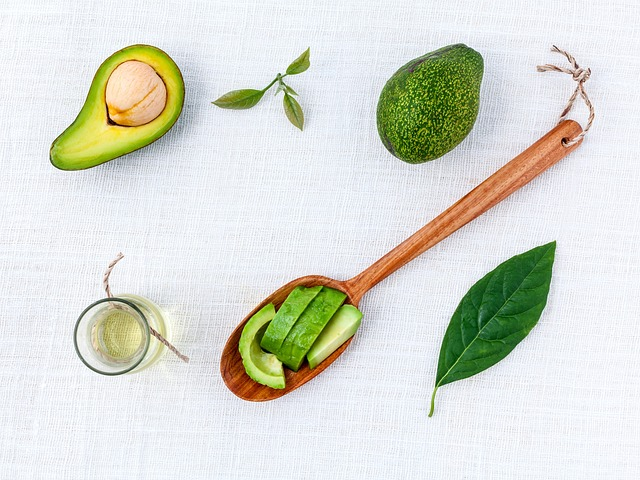
Remember to consider your personal dietary needs and preferences when choosing sides. These options provide a variety of textures, flavours, and nutrient profiles to enhance your keto beef stroganoff experience while keeping your meal low in carbohydrates.
Should I Head to the Supermarket to Buy Beef?
When it comes to buying beef for your keto beef stroganoff, there are a few options to consider, depending on your preferences and availability. Here are some suggestions:
-
Local Butcher: Visiting a local butcher shop is often an excellent choice as you can get personalised service and high-quality cuts of meat. Butchers can provide recommendations, help you select the right type of beef for your stroganoff, and even offer specific cuts like tenderloin or sirloin. They can also ensure the meat is fresh and may be able to provide information about the sourcing and quality of the beef.
-
Farmer's Market: If you can access a farmer's market in your area, consider buying beef from local farmers. This way, you can support local producers, have the opportunity to learn about their farming practices, and get fresh, high-quality meat. Many farmers follow sustainable and organic practices, which can be beneficial if you prefer to choose ethically raised and hormone-free meat.
-
Grocery Store: Most grocery stores have a meat section where you can find various cuts of beef. Look for grass-fed, organic, or locally sourced options if available. Read the labels carefully to ensure the beef meets your criteria for quality and sustainability.
-
Online Meat Delivery Services: There are also online meat delivery services that offer a wide range of beef options. These services often provide detailed information about the sourcing, quality, and cuts of meat they offer. They can be a convenient option if you prefer to have meat delivered directly to your doorstep.
Regardless of where you buy your beef, looking for high-quality cuts that fit your dietary preferences is essential. Opt for grass-fed or pasture-raised beef whenever possible, as they tend to be higher in beneficial nutrients and healthy fats. Additionally, consider the marbling and tenderness of the meat when selecting cuts for your beef stroganoff.
Remember, the beef's quality can significantly impact your dish's taste and overall experience. So, take your time to find a reputable source that aligns with your values and delivers the best beef for your keto beef stroganoff recipe.
Bonus! Keto Beef Stock Recipe
Ingredients
-
4-5 pounds of beef bones (such as marrow bones, knuckle bones, or soup bones)
-
1 large onion, roughly chopped
-
2 carrots, roughly chopped
-
2 celery stalks, roughly chopped
-
4 cloves garlic, smashed
-
2 bay leaves
-
1 tablespoon whole peppercorns
-
1 tablespoon apple cider vinegar
-
Water, enough to cover the bones
-
Salt, to taste
Instructions
-
Preheat your oven to 400°F (200°C). Place the beef bones on a baking sheet and roast in the oven for about 45 minutes to an hour. This step helps to enhance the flavour of the stock.
-
Transfer the roasted bones to a large stockpot or slow cooker. Add the onion, carrots, celery, garlic, bay leaves, and peppercorns.
-
Pour in enough water to completely cover the bones and vegetables. Add the apple cider vinegar, which helps extract minerals from the bones.
-
Place the pot on the stovetop or set the slow cooker to low heat. If using a stovetop, bring the mixture to a boil, then reduce the heat to low and let it simmer gently. If using a slow cooker, set it to low heat and allow it to simmer for 24-48 hours.
-
Skim off any foam or impurities that rise to the surface of the stock during the first few hours of cooking. This helps to maintain clarity and flavour.
-
After the designated simmering time, remove the pot from heat and let it cool slightly. Strain the stock through a fine-mesh sieve or cheesecloth into a clean container, discarding the bones and vegetables.
-
Season the stock with salt to taste. You can adjust the salt level based on your preference and the intended use of the stock.
-
Let the stock cool to room temperature, then refrigerate it for several hours or overnight. This allows the fat to solidify on the surface, making removing it easier.
-
Once chilled, skim off the solidified fat with a spoon or strainer. Your homemade keto beef stock is now ready to use or can be stored in the refrigerator for up to 5 days or in the freezer for several months.
Homemade keto beef stock adds depth and flavour to your keto recipes. It can be used as a base for soups, stews, sauces, or any recipe that calls for stock. Enjoy this homemade stock's rich, nourishing taste while staying true to your low-carb lifestyle.
